|
ISS
"ET Shadow" experiment
|

|
|
The
Mission Control Center of TsNIIMash at Korolev, Moscow region. |
ISS
crew requests the co-operation of the ham community
The
Central Research Institute for Machine Building (Russian
acronym TsNIIMash) is the leading institute of the Russian
Aeronautics and Space Agency Rosaviacosmos
involved in the development of rocket and space technology.
TsNIIMash
(originally designated NII 88) was established in May 1946 as
a main research design and production organization
specializing in the development of long range ballistic
missiles, air defense missiles and their propulsion units.
TsNIIMash
is today involved in the design
and exploratory research to substantiate a reasonable
engineering policy in the development of rocket and space
technology. It is involved in fundamental
and applied research in aerogasdynamics, heat transfer and
thermal protection, dynamics, strength and reliability of
launch vehicles, spacecraft, orbital stations and space
vehicles and last but not least it ensures the control
of manned spacecraft orbital stations and research and
commercial space vehicles.
ET
Shadow
Many
space professionals are looking forward to further space
exploration using electric thrusters (ET). Unlike ordinary
chemical propulsion systems, ET demonstrate much more higher
exhaust velocity, since the propellant is accelerated for
propulsion by electric power being supplied from an onboard
source. The thrust produced by ET is very small - not more
then a few gramms so that ET cannot burst a rocket from the
Earth surface. ET can tick only on board any orbiting
satellite or spaceship.
The
high exhaust velocity distinguished by ET offers noticeable
propellant saving for given maneuver in space as compared to
chemical propulsion so that mass reduction of a communication
satellite for instance may be up to a few hundreds kilos. As a
result this more lightweight satellite could be lifted in orbit by
less heavy launch vehicle saving millions of dollars.
|
Project
ET Shadow is dedicated
to
the memory of the crew of Columbia STS-107 |
|

|
Columbia
Crew
The
seven members of Columbia crew. Sit down at
foreground are astronauts Rick D. Husband (left),
mission commander; Kalpana Chawla, mission specialist;
and William C. McCool, pilot. Stand up (form left)
are astronauts David M. Brown, Laurel B. Clark, and
Michael P. Anderson, all mission specialists; and
Ilan Ramon, load specialist representing Israel
Space Agency, ISA.
|
|
Money
is not the only benefit
However
money saving is not the only profit. A less heavy rocket is less
hazardous for environment. ET themselves are ecologically pure using
as non-detrimental propellants as noble gases, hydrogen, ammonia.
The
benefit of electric propulsion will be more fully realized when
significant cargo traffic arises in space providing deployment of
large space structures, colonization of the Moon and planet
exploration. That is why ET are included in such ambitious projects
currently under development as Electric Orbit Transfer Vehicle,
Lunar Ferry and some unmanned mission to planet. Over these projects
the flight use of ET would save hundreds millions of dollars with
better ecology.
Currently
we are present at the beginning of the "gold century" of
electric propulsion. To make it reality the electric propulsion
community in many countries is going on with research and
development of ET of different types either for secondary on-orbit
application or for primary propulsion of multikilowatt level.
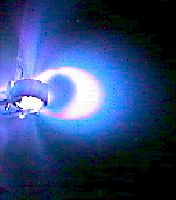 |
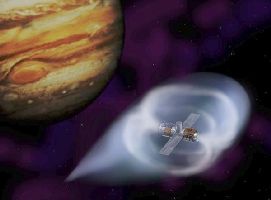 |
|
In
the future the electric propulsion (plasma or ionic
engine) could drive a space probe like we already did
with the Deep Space-1 probes and recently sending SMART-1 to the Moon and some others.
At left an experiment showing a luminous plasma plume
inflating an invisible magnetic bubble inside the
vacuum chamber at NASA's Marshall Space Flight Center.
At right charged particles in the solar wind hit the
electromagnetic bubble surrouding a spacecraft, apply
pressure, and propel it. This mini-magnetospheric
plasma propulsion is called M2P2 for short. A 15
km-wide miniature magnetosphere one astronomical unit
from the Sun would feel 1 to 3 Newtons of force from
the solar wind. According NASA engineers that is
enough to accelerate a 200 kg spacecraft from a dead
stop to 80 km/s (288000 km/h) in only 3 months ! |
|
However
what is a place of radio amateurs in the matter ? VHF-community
could play its role in ET implementation if wants. Integration
of ET with onboard equipment poses a certain set of problems to be
solved such as electromagnetic compatibility of ET. Particularly the
matter is that highly ionized exhaust plumes of ET may scatter
RF-signals producing large "dead" zone for communications.
This
plasma screening effect should be thoroughly studied before electric
thrusters become standard onboard equipment. The investigation will
help designers of future electrically propelled spacecrafts to
minimize the hazard of communication disruption by ET plasma plumes.
History
of the project
If
the history of the electric engine goes back to several decade, the
discover of the "dead" zone around the plasma engine is
quite new.
|
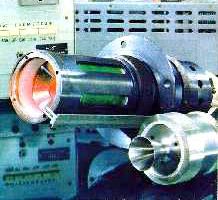
|
|
Fligh-designed alkaline plasma injectors EPICURE. |
In
1987 specialists of Central Research Institute of Machine Building
(TsNIIMash) conducted a series of space plasma experiments in order
to evaluate the shape of mentioned above "dead" zone using
KOSMOS satellites with onboard
arcjet plasma source EPICURE.
The
well known method of radio sounding was used for plasma monitoring.
The telemetric and command signals emitted by onboard antennas
played a role of sounding signals. Passed through plasma these
signals were simultaneously received by a number of on-ground
measuring sites. The shadow effect was clearly observed however the
precise data on the shadow boundary shape and its dynamics could not
be obtained in the experiments of 1987 since the receiving network
was too rarefied. Deployment of properly dense special receiving
network is extremely expensive and consequently unrealistic.
Therefore
the project director thought using the world network of hams.
The
role of radio amateurs
Possible
solution is to use available worldwide spread network of amateur
working with VHF
receivers. This idea was put in the base of an proposal to perform a
new plasma space experiment on the International Space Station (ISS)
almost in the same layout as in 1987.
Onboard
beacon operators should be the ones from the ISS crew transmitting a
sounding signal (the onboard beacon), while the on-ground
receiving network operators should be represented by a network constituted
of amateur radio like YOU !
Except
the scientific data, realization of the space experiment
"Shadow" will give an unique experience in involving
intellectual and technical potential of the international radio amateur
community as well as Internet technology and resources for
monitoring of the near-Earth space and to evaluate capability to use
this potential in perspective scientific projects.
Methodologically
SpEx "Shadow" is oriented to using of amateur packet radio
and Internet technology and resources.
SpEx
"Shadow" objectives and lay out
The
objectives of the work is observation and evaluation of
refraction/scattering effects in artificial plasmas using method of
RF sounding in space experiments under different geophysical
conditions.
In the chosen region the onboard arcjet source injects a plasma
plume in space and the onboard radio beacon transmits VHF sounding
signals in the form of the Universal
Time Marks. Passed through the
plasma these signals are being instantly received by an on-ground
measuring VHF network. Due to refraction/scattering of the sounding
signals in the exhaust plume, the shadow region would arise adjacent
to the satellite. When the shadow boundary running after the
satellite along the Earth surface reaches any on-ground receiving
site the signal cut-off is to be registered.
 |
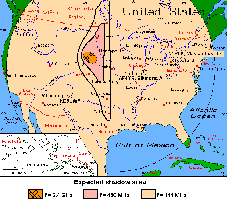 |
|
At
left the SpEx
"Shadow" lay out. At right the "dead" zone over
the USA when the plasma plume is exhausted. |
|
The task of every
individual participant is to register moments of signal cut-off and
following signal restore using the Universal Time marks and to
address this information along with data on its geographical
position to the Information Storing Center. Every operation sequence
would take 6-8 min. while the satellite is passing between two
opposite points of the local radio horizon.
It
is interesting to perform the experiment in different geophysical
conditions particularly while flying over Europe (including the
former USSR), Japan, North America, Australia and some other regions
where we will be lucky to manage a receiving network dense enough.
For an example the previous image shows the expected borders of a radioshadow for the North
American measuring field.
Packet
radio and Internet
The
amateur packet radio technology in the SpEx "Shadow" as
proposed by astronaut Alexander
Kalery, alias U8MIR offers the possibility to use Internet transport
resources either for net-work notification or for data collection.
Principally the available receiving network may be provided with
Universal Time Marks if the onboard radio beacon merely transmits packets
of minimal duration in format of AX.25 Protocol. This
promises to perform large-scale monitoring of an artificial plasma
nonhomogeneity using the mosaics of on-ground receiving sites.
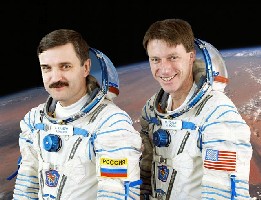 |
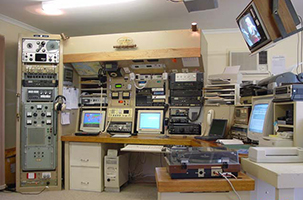 |
|
When
amateurs and professionals work together. At
left Alexander Kalery, alias U8MIR and Mike Foale,
alias KB5UAC
joining ISS crew in 2003. At right Tony Hutchison,
alias VK5ZAI
radioshack showing at center the FT-736R transceiver
to work satellites including ISS by voice, and at right the packet radio
installation (blue screen showing a receiver). It takes advantage of the WinRADIO
WR-1550i radio card, one of the first DRM
receiver available on the market covering
frequencies between 150 kHz and 1.5 GHz in all modes.
Roger ISS, downlink open ! |
|
The
same technology can be also applied in space experiment on sounding
of not artificially injected plasma, but of the natural ionospheric
plasma in HF frequency band (14 MHz). It is expected, that due to
dispersion of sounding radiation in ionospheric plasma, an
"irradiated" spot should appear on the Earth surface, and
determination of boundaries of this "irradiated" spot is
the purpose of space experiment (legend "Spot"), which can
be carried out not necessarily on the ISS.
Expected
results
The
scientific results the SpEx "Shadow" will help designers
of future electrically propelled spacecrafts to minimize the hazard
of communication disruption by ET plasma plumes.
Except
the scientific issues, realization of the space experiment
"Shadow" will give an unique experience in involving of
intellectual and technical potential of International radio amateur
community as well as Internet technology and resources for
monitoring of the near-Earth space and to evaluate capability to use
this potential in perspective scientific projects.
Actually
the space experiment "Shadow" is an interesting attempt to
use Internet for principally new goal - not only for information
spreading but also as an effective measuring tool in spatially
large-scale scientific researches.
The
space experiment "Shadow" may also bring an important
social result attracting public attention to advanced technology,
astronautics, amateur packet radio and Internet.
With
really mass, voluntary and gratuitous participation of VHF-amateurs
this project would become a humanitarian world wide action uniting
many peoples of different countries with interesting and useful work
for future enhancing the spirit of cooperation, mutual understanding
and friendship.
As
it was mentioned above the space experiment "Shadow" may
be successfully performed under the condition that the number of
participants will be great enough . The greater this number the more
precise scientific result would be issued.
As
claims for participation in the SpEx "Shadow" appear at
the Information Storing Center in response to this initial
invitation, we are going to select perspective "measuring
fields" where the receiving network is dense enough and where
the bulk of activity will be further concentrated.
The
SpEx "Shadow" will be performed in two stages :
-
of "cold" (with no plasma injection) training seances and
-
of full scale "hot" (with plasma injection) experiments.
Being
lucky and fast in managing of the receiving network, we may begin
the "cold" stage probably this year on the International
Space Station.
After
successful fulfillment of the "cold" training phase it
will be possible to accept the justified solution on realization of
a series of full scale "hot" experiments probably an year
later.
What
to do if You decide to participate
Participating
in this experiment is easy and I encourage all VHF licensed hams to
subscribe. You need a V/UHF transceiver
and any kind of V/UHF antenna, from the 23 elements with preamp and
rotator to
the simple whip antenna. Optionaly, in the same time you can
made voice contact with the crew on ISS using a QRP power as small
as 5 watt (i.e. using a hand held VHF radio Alinco DJ-V5 about the
size of a packet of cigarettes !). Note that you do not need an
emitter for on-ground operations, the project leader requesting only
a report using a time stamp on the received signal (see below).
|

|
|
WXTrack
tracking ISS |
SWLs
and all amateurs fan of shortwaves can also take part in this project
using a simple V/UHF receiver (including WinRADIO cards) or a scanner fixed on the
frequency of 145.800 MHz. Other frequencies are at your disposal on
UHF and higher bands. Contact Valentin
Strashinski for detail.
Then
you need a computer to decode the packet
radio and a tracking software like WXTrack
or Nova for Windows with
the last Keplerian
data file. This software will give you the location of the Space Station
in real-time, and optionaly will allow you to track its move if you
use a directive antenna with a rotator. If you
simply use a
ground plane vertical or a whip antenna the rotator is useless.
Connect
also a cable between your RTX or scanner extension speaker
socket and your computer sound cards "Line In" or
"Mic" input so that the computer software can decode the
Space Station signals. If you don't have one or cannot make a cable
for the signal, try just putting the computer microphone (i.e. the
one use with Echolink, your webcam or with MSN Messenger) near the
receiver speaker and wait for the modem like sound...
|
Listen
to Packet radio bursts
|
|

|
|
The
speed of the packet you are listening for is only
1200 baud. To know what they sound like when
trying to find it on a receiver here is an audio
sample of packet radio bursts. A document prepared
by VK3UKF (.wav of 118 KB).
|
|
In
order than your computer decodes the packet radio you need to
download 3 programs : the AGW software, its FITS driver,
and UISS communication software. Install all them in your
computer. UISS will not work if AGW is not running. Practically AGW
sends information to the UISS program using the FITS driver.
The
UISS communication software should be registered with Guy
Roels, alias ON1DHT to enable all allowable functions. He
requests only a photo of yourself for identification to send him by
email. This software is called a cardware instead of a shareware and
it is free of charge.
If
you don't like UISS you can use the monitor program provided in the
AGW Packet Engine.
Software
to download:
AGW
packet engine and FITS driver, by SV2AGW
UISS spacecraft
communications software, by ON1DHT
The
idea of using a program to capture individuals packets of data
emitted by ISS allows to each one of them to get a time stamp.
Logging
the time allows the project leader to know :
- When you first heard ISS (the instant when ISS appears over the
horizon)
- When you first lost contact (while ISS is overhead and you will
now be in the ET Shadow)
- When you regained contact (while ISS is overhead and you will now
be out of the ET Shadow)
- When you lost contact for good (ISS disappears over the opposite
horizon)
Your
log must be then sent to your national co-ordinator by email or
directly to Valentin
Strashinski.
After
this the project leader could plot these data on a map to analyze the signals
extinction and trace the "dead" zones along the ISS path in the
different ET configurations.
One
step beyond
If
you do not mind to take part in this experiment, do as follows :
1)
e-mail your decision to project author Valentin
Strashinski at Information Storing Center or at Shadow
with short personal data : your name, call sign, city, QTH loc,
available radio equipment, your wish on experiment run conditions
(day or night time, week-end and so on);
Please,
do not put this action off since your claim may support the official
decision on the SpEx "Shadow" performing as a proof that
amateur receiving network could actually be formed and activated.
2)
Look through the method of sounding signals generation and
measuring, data collection and processing;
3)
Permanently look through updated regional network notification;
4)
Take part in "cold" and "hot" experiment runs
following the Operating instruction for receiving network operators;
At
last, for the good news,Rosaviakosmos is going to award every participant of the space experiment
"Shadow" with special diploma.
NB.
End 2005, KGB put in jail three leading academics from TsNIIMash
(Here is an English
news about this). According to FSB, they exported secret material to
China. But according to ESISC, this material could not serve
military purposes.
In
all cases, between end 2007 and 2008, the TsNIIMash
web site was closed.
Good
news, since 2008 Valentin Strashinski works again on the ET Shadow project.
A
summary of this article was published on QRZ.ru.
For
more information
TsNIIMash
website
Valentin
Strashinski's email
VK3UKF
website, the australian ET Shadow section
VK5ZAI
website, member of ARISS and AMSAT
WinRADIO
(radio cards)
AGW
packet engine and FITS driver, by SV2AGW
UISS spacecraft
communications software, by ON1DHT
ISS
fan club
Back
to Menu
|